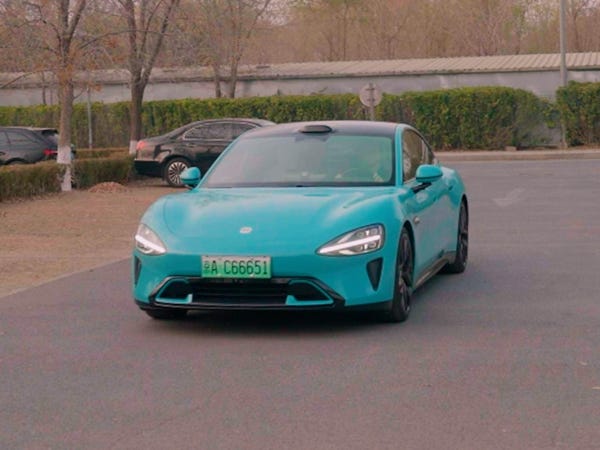Here’s a transcript of the video.
Lamborghini has finally added a hybrid to its lineup, and it’s kind of bad for the environment. When you think of hybrids, you think environmentally friendly, right? But Lamborghini is taking a different approach, using hybrid technology to boost performance without taking fuel efficiency into consideration. Which raises the question: Should automakers use hybrid systems to increase speed rather than reduce pollution?
Hybrids have grown in popularity since they were first introduced 20 years ago. Now, almost every automaker offers a hybrid option, and most hybrids can double the gas mileage of a standard car. But Lamborghini’s foray into electrification, the Sián FKP 37, doesn’t save fuel. The Sián is a blend of the Terzo Millennio concept and the iconic Countach. Instead of fuel efficiency, Lamborghini is focusing on performance. And perform it does. It’s the fastest Lamborghini ever, with a top speed of over 217 mph, and goes 0 to 62 in just under 2.8 seconds, just two-tenths of a second shy of Tesla’s Model S. There’s no doubt that Lamborghini saw what electric motors could do and wanted to try something different for itself. The Sián’s engineering is ingenious. Instead of a battery pack, Lamborghini opted for a supercapacitor, which is lighter, fire-resistant, more powerful, and fully charges in a fraction of the time of a battery pack. The only downfall is the lack of range, which limits the Sián’s fully electric drive mode to parking and reversing. But the supercapacitor is the secret to making it the fastest-accelerating Lamborghini ever, virtually eliminating lag between gear changes, providing instant torque via the electric motors, and fully recharging during the regenerative braking process to repeat its performance around the track. But Lamborghini’s chief technology officer says the supercapacitor is not too hot for emissions.
Meanwhile, Lamborghini’s sister company Porsche has produced the 918 Spyder, a superhybrid that boasts a top speed of 211 mph and makes the 0-62 time faster than the Sián at 2. 6 seconds. But even more impressive, it achieves a rating of 22 miles per gallon and a gasoline equivalent of 67 mpg when using the hybrid transmission. And it came out in 2013. The Porsche runs faster, has a comparable top speed and still manages to be more fuel efficient than the Lamborghini Sián. The fact is, you don’t have to sacrifice power for performance. That’s what hybrid cars are. and electrical The answer to our climate replacement problems? Probably not. But they may have a role to play. The EPA states that up to 75% of automobile carbon monoxide emissions in U. S. cities come from motor vehicles. So yes, car brands have a role to play.
There may be positive long-term steps for the company. Lamborghini says it plans to use batteries instead of supercapacitors in its next hybrid, which will result in higher fuel consumption. But the challenge is that, for now, Lamborghini’s only hybrid does. It doesn’t do much in terms of fuel efficiency.
Following is a transcript of the video.
Lamborghini finally added a hybrid to its range, which is quite bad for the environment. Who says hybrid, says organic, right? But Lamborghini is taking another approach, employing hybrid generation for functionality without regard to fuel efficiency. Which begs the question: Are automakers worth using hybrid systems to increase speed rather than reduce pollution?
Hybrids have grown in popularity since they were first introduced 20 years ago. Now, almost every automaker offers a hybrid option, and most hybrids can double the gas mileage of a standard car. But Lamborghini’s foray into electrification, the Sián FKP 37, doesn’t save fuel. The Sián is a blend of the Terzo Millennio concept and the iconic Countach. Instead of fuel efficiency, Lamborghini is focusing on performance. And perform it does. It’s the fastest Lamborghini ever, with a top speed of over 217 mph, and goes 0 to 62 in just under 2.8 seconds, just two-tenths of a second shy of Tesla’s Model S. There’s no doubt that Lamborghini saw what electric motors could do and wanted to try something different for itself. The Sián’s engineering is ingenious. Instead of a battery pack, Lamborghini opted for a supercapacitor, which is lighter, fire-resistant, more powerful, and fully charges in a fraction of the time of a battery pack. The only downfall is the lack of range, which limits the Sián’s fully electric drive mode to parking and reversing. But the supercapacitor is the secret to making it the fastest-accelerating Lamborghini ever, virtually eliminating lag between gear changes, providing instant torque via the electric motors, and fully recharging during the regenerative braking process to repeat its performance around the track. But Lamborghini’s chief technology officer says the supercapacitor is not too hot for emissions.
Meanwhile, Lamborghini’s sister company, Porsche, produced the 918 Spyder, a super-hybrid that boasts a top speed of 211 mph and makes the 0-to-62 run quicker than the Sián, at 2.6 seconds. But even more impressively, it achieves a miles-per-gallon rating of 22, and a 67 mpg of gasoline equivalent while running on the hybrid drivetrain. And it came out in 2013. The Porsche accelerates faster, has a comparable top speed, and still manages to be more fuel-efficient than the Lamborghini Sián. The point is, you don’t have to sacrifice efficiency for performance. So, are hybrids and electric cars the answer to our climate-change problems? Probably not. But they could have a big role to play. The EPA says that up to 75% of carbon monoxide emissions in US cities come from motor vehicles. So, yes, automakers do have a big role to play.
There may be positive steps in the company’s future. Lamborghini says it plans to use batteries instead of supercapacitors in its next hybrid, which produce higher fuel consumption. But the challenge is that, for now, Lamborghini’s only hybrid doesn’t add much in terms of fuel efficiency.
Gonna

